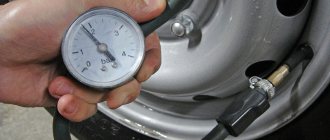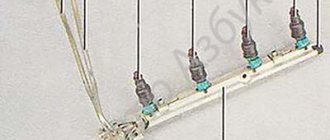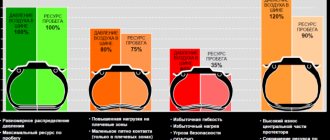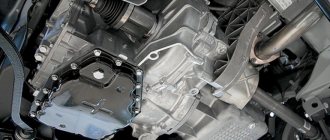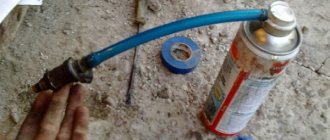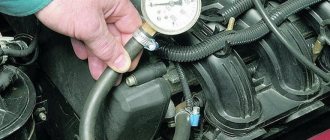The manufacturer sets the recommended tire pressure for Lada Kalina at 2.2 - 2.3 Atm. For front and rear axle. The manufacturer specifies reference values used under rated operating conditions. This:
- Outboard temperature within +20-25°C;
- Full load no more than 300 kg;
- Asphalt road surface of adequate quality.
In reality, indicators may differ significantly from those set by the factory. Users have calculated for themselves certain adjustments to the optimal pressure. In summer, during extreme heat, it is recommended to lower the tires by 0.2-0.3 bar. This is especially true when driving on the highway. Due to strong friction, the wheels heat up, which leads to the expansion of the air inside the cylinder.
In winter, the reverse process occurs. For every 10°C decrease in temperature, the pressure in the wheels drops by approximately 0.2-0.3 Atm, which indicates the need to inflate tires before leaving with a reserve.
Separately, you should consider the option of traveling on a bumpy road or dirt road. Here, hard tires can make the ride less comfortable. On the other hand, broken asphalt and under-inflated slopes cause cuts in the side of the slope. It is recommended to monitor the operating pressure whenever the road conditions change.
Separately, you should consider the difference in the tires themselves. Different models are distinguished by softness or hardness. On ROSSAVA and Continental tires with similar tread, the optimal pressure will differ slightly due to the difference in rubber composition.
Kalina Cross
Separately, we should highlight the model where wheels with standard size R15 are mounted. The factory recommends pumping low-profile tires a little harder. This is 2.4/2.5 ATM for the front and rear axles of the vehicle.
This is because the standard low-profile Pirelli tires need to be stiffer to improve traction and control of the car. The comfort of passengers and the driver is not taken into account here - the racing version is designed taking into account aggressive use.
Car tire pressure, how important is it?
The manufacturer always gives recommendations regarding the tire pressure of the car. There is a special table where, depending on the model and type of tire, it is indicated what the value should be for different types of cars.
However, we should not forget that it also depends on load distribution, ambient temperature and other factors.
Control measurement of tire pressure on a VAZ 2106 car
With overinflated wheels we observe the following:
- reduction of drag coefficient;
- lower degree of deformation;
- smaller contact patch with the road;
- reduced shock absorption;
- increased controllability.
When the wheels are underinflated, the following phenomena are observed:
- increasing the size of the contact patch with the road;
- increasing the resistance coefficient;
- increased fuel consumption;
- improving the smoothness of the ride;
- deterioration in vehicle controllability.
Car pressure gauge - dial and electronic with LCD screen
In both the first and second cases, tread wear increases. In the first case, the middle of the tread deteriorates, in the second, the sidewalls.
Tires R15
For modifications of cars with 15-radius wheels, the manufacturer provides a more stringent operating mode. The company’s form table indicates that the optimal pressure will be within 2.4/2.5 BAR, respectively, for the front and rear of the car.
It is strictly not recommended to reduce the level of pumping below normal. Actions may cause damage to the sidewall of the tire or its self-disassembly while driving.
Optimal car tire pressure
The main task of car tires is to provide effective traction between the car and the road. With normal air pressure in the tire, the load in the contact patch of the wheel with the road is distributed evenly, due to which tire wear occurs evenly, the car handles well and fuel consumption is within normal limits.
There are three possible scenarios in which the tire pressure will not be optimal:
- Increased pressure (tires overinflated);
- Low pressure (tires underinflated);
- Different pressure in all wheels.
Check the tire pressure with a special tire pressure gauge. This should only be done on cold tires, that is, before leaving the parking lot or garage.
If deviations from the normal pressure are detected in any of the tires (see the table below for what pressure should be in the tires of your passenger car), such a wheel must either be inflated or excess air released from it - that is, the pressure must be adjusted to norm. In one of our articles, we already talked about which car compressor is best for inflating tires.
It is worth noting that the tire pressure in winter should be exactly the same as in summer. But due to the sharp temperature change, in winter, monitoring the air pressure in the wheels needs to be approached more responsibly.
It is better to inflate your tires outside. Also, do not forget to check the tire pressure when there are significant changes in ambient temperature, and if necessary, adjust it:
- if it gets cold outside, the pressure in the tires will decrease,
- and when it gets warmer, it will rise.
It should also be remembered that while the car is moving, the tires heat up, the air in them expands, and the pressure increases, and the handling and braking properties change.
Increased tire pressure
With increased tire pressure, the load at the point of contact of the wheel with the road acts to a greater extent on the central part of the tire tread, thereby causing uneven wear of the tire.
On overinflated wheels, the car brakes worse! This happens because if the tires are overinflated, the contact patch with the road decreases, which means the friction force that keeps the car from sliding decreases. At the same time, the braking distance increases noticeably.
In just twenty minutes of driving, taking turns as aggressively as possible, the pressure in the car’s tires can increase by 0.5 atmospheres. And on long trips at high speed, the pressure in the tires can increase to 4-5 atmospheres. And modern tires are designed for this.
But if the tire has a hernia or cut, it can heat up and explode while driving. But on the road it’s a disaster.
Low tire pressure
Wheels lowered to just half an atmosphere change the behavior of the car and become unusable much earlier than expected. When the pressure is low, the load on the tire surface is distributed unevenly. In this case, the sidewalls of the tire where the tire contacts the road are subject to increased wear.
The sidewalls of flat tires are softer and bend when you turn the steering wheel. The trajectory of the wheel and tire do not match, so the car responds to the steering wheel late.
Moreover, if the tire pressure is reduced, the wheel may even come off during a sharp turn. Therefore, it is very important to regularly check the tire pressure and maintain it within the normal range.
This is especially true in winter, since in cold weather the tire pressure can easily drop by 0.3 (or even 0.5) atmospheres.
Lada Kalina tire pressure table
| Tire size | Front axle | Rear axle | ||
| Summer | Winter | Summer | Winter | |
| 175/70R13 | 2,2 | 2,4 | 2,3 | 2,5 |
| 175/65R14 | 2,2 | 2,4 | 2,3 | 2,5 |
| 185/55R15 | 2,4 | 2,6 | 2,5 | 2,6 |
The norm for each season is different.
Pressure in Lada wheels in winter
In winter and summer, the pressure inside the tire changes due to environmental temperature changes.
For example, in the summer, when it is very hot, the air inside the tire heats up and its volume increases. Therefore, the wheels need to be slightly underinflated, about 0.3 atmospheres. And in winter exactly the opposite happens. Due to low temperatures, the volume of air in a tire decreases, and therefore they should also be pumped to 0.3 atmospheres. It is very important where exactly the car is located. If it is in a warm room, then when measuring pressure the pressure gauge will show optimal readings. But if you go outside in the cold, the tire performance will drop by about 0.4 Bar. And the car will already be driving on underinflated tires, and this is unsafe. Therefore, you should inflate the wheels in the garage and slightly increase the standard values, since they fall in the cold.
Fans of the Lada Kalina station wagon often do not think about changes in tire pressure at different times of the year. For such cars, the optimal indicators are 2.2 atmospheres on the wheels of the front axle, and 2.3 on the rear. Most drivers agree with these recommendations from the manufacturer and do not report severe discomfort while driving.
But in winter, many people deviate from these standards. In cold weather, the front tires are inflated to 2.0 Bar, and the rear tires to 2.2 Bar. This takes into account that the tires on the car are factory. If the car is re-shod with wide-profile tires, the pressure readings increase. The front should be 2.4 Bar and the rear should be 2.5 Bar. Low-profile and narrow tires require 1.9-2.0 atmospheres on the front axle, and 2.0-2.2 on the rear.
Kalina
The Lada Vesta sedan has a greater maximum load capacity than the previous model. The load capacity index is up to 615 kilograms. The instructions indicate pressure parameters equal to 2.1 atmospheres, both for the front and rear wheels. As the load increases, the rear wheels are pumped up to 2.2 bar.
The tire pressure of the Lada Vesta Cross has slightly different parameters. The factory wheels on the car cost R17, so the front wheels require inflation to 2.2 atmospheres, and the rear wheels to 2.4. But if tires of a different size are installed, then you need to rely on the general Lada pressure table.
New Lada: Jerks at low speeds and when starting off Lada Kalina
Fans of the Largus model should know that the atmospheric performance in this car is higher than in the previous models under consideration. The pressure in Largus wheels for tires R14 and R15 is 2.4 Bar on the front axle, and 2.6 on the rear. But owners of such cars note that with such parameters the car drives very hard, so they often underestimate the recommended readings.
At the same time, there is no significant wear of the rubber. But you shouldn’t get carried away with underestimation, as this can lead to a lot of problems. If the driver is a fan of fast driving, then lowering the pressure by 1.0 Bar will be quite justified. The rubber heats up at high speed, and the volume of air increases, so such a decrease will not affect it.
"Lada Hatchback"
Check your car tire pressure regularly
Owners of VAZ cars, like any other brands, are recommended to regularly check the level of tire inflation - at least once a month. Practice shows that over the course of a month the pressure decreases by 0.4 atmospheres. In this case, it is necessary to pump up the wheels.
To measure, you don’t have to constantly go to a service station - you can do it yourself using a pressure gauge. We do it this way:
- We reset the device readings.
- Remove the cover from the spool.
- We put the fitting of the device on the nipple and press.
- We take readings from the device.
Check your vehicle tire pressure regularly
Since temperature can significantly affect the readings, it is necessary to take them before leaving the garage on “cold” tires. Remember that regular monitoring is the key to your safety and long vehicle life.
Recommended tire pressure for VAZ 2107/2110 and 2112
The manufacturer recommends the optimal degree of tire inflation for its own vehicle models, taking into account all design features and the load on the wheelsets.
The complex formula affects maximum loads, wheel speeds and the “degree of roughness” of domestic roads. Violating the parameters is strictly not recommended, as this may impair the predictability of the car.
You can find an indicator of what the tire pressure should be in the Lada Priora and other modern modifications in two indicators.
- Typically the metal tag is located on the B-pillar near the driver's door. The nameplate contains the necessary numbers and recommendations. On other models of the manufacturer, the information element may be located under the hood, in the trunk or on one of the pillars.
- Factory instructions. The owner's manual usually contains comprehensive information about service intervals, correct tire inflation, and factory recommendations.
Tire inflation on Lada cars / Tire pressure table
It is most convenient to view the tire pressure of the Lada Granta in winter in the table. There is also a complete list of popular domestically produced cars.
Light pressure, BAR
Pressure under load, bar
| Model |
| Priora 2170 |
| Kalina |
| Largus |
| 2101/2107 |
| Granta |
| 2109/99 |
| 2114/2115 |
| 2110/2112 |
Adjustment for tire inflation in winter depending on external factors
The tire pressure of the VAZ 2107 in winter and similar models (2101-06) is kept at 1.6/1.9 At for an empty vehicle and 1.8/2.1 for a loaded vehicle, respectively, on the front/rear axle. This is true on factory P13 wheels with a sidewall height of 70-75. At the same time, on station wagons (02 and 04), the rear axle will need to be pumped up by 0.2 BAR more during full load.
In cold weather, it is recommended to increase pumping by 0.3-0.5 kg, which is caused by compression of oxygen inside. The subsidence of the cylinders softens the sidewalls, and the tread shoulders can slip on loose snow or slippery ruts.
Note!
Tire inflation is carried out based on the approximate temperature and pressure differences. If the tires start to blow out on the street (no t° imbalance is expected), you can stop at the factory mark.
For the summer period, it is necessary, on the contrary, to bleed off the air volume, due to the expansion of oxygen when heated.
